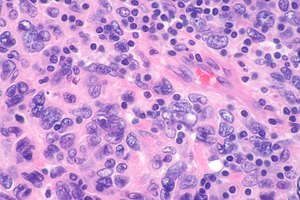Follicular dendritic cell sarcoma
Jump to navigation
Jump to search
The printable version is no longer supported and may have rendering errors. Please update your browser bookmarks and please use the default browser print function instead.
| Follicular dendritic cell sarcoma | |
|---|---|
| Diagnosis in short | |
 Micrograph showing a follicular dendritic cell sarcoma. The (benign) interspersed lymphocytes are a characteristic finding. H&E stain. | |
|
| |
| Synonyms | follicular dendritic cell tumour, follicular dendritic cell neoplasm |
|
| |
| LM | oval or spindle-shaped cellular & nuclear morphology, variable architecture (sheets, fascicles, whorles, storiform pattern), nuclei with small nucleoli and clear or dispersed chromatin, multinucleated cells, interspersed small lymphocytes, +/-necrosis, +/-marked nuclear atypia, +/-abundant mitoses. |
| LM DDx | histiocytic sarcoma, thymoma, other spindle cell lesions |
| IHC | CD21 +ve, CD23 +ve, CD35 +ve, Ki-M4p +ve, Ki-FDRC1p +ve, vimentin +ve |
| Associated Dx | Castleman disease, hyaline-vascular type |
| Prevalence | very rare |
| Treatment | excision |
Follicular dendritic cell sarcoma, abbreviated FDCS, is a very rare malignant tumour.
It is also known as follicular dendritic cell tumour (abbreviated FDCT),[1] and follicular dendritic cell neoplasm.[2]
General
- Very rare.
- Behave like a low-grade sarcoma.[3]
- Reported association with Castleman disease (hyaline-vascular type).[3]
WHO 2001 classification of dendritic cell neoplasms:[4]
- Langerhans cell histiocytosis.
- Langerhans cell sarcoma.
- Interdigitating dendritic cell sarcoma/tumour.
- Follicular dendritic cell sarcoma/tumour.
- Dendritic cell sarcoma, not specified otherwise.
Gross
Features:
- Often a head and neck lesion.[citation needed]
Microscopic
Features:[3]
- Oval or spindle-shaped cellular & nuclear morphology.
- Variable architecture (sheets, fascicles, whorles, storiform pattern).
- Nuclei:
- Small nucleoli.
- Clear or dispersed chromatin.
- Multinucleated cells.
- Interspersed small lymphocytes - distinctive feature.
- +/-Necrosis.
- +/-Marked nuclear atypia.
- +/-Abundant mitoses.
DDx:
- Histiocytic sarcoma.[5]
- Thymoma.
- Spindle cell lesions such as sarcomatoid carcinoma.
- Meningioma.[citation needed]
Images
Related images
www
- FDCS (ajronline.org).[1]
- FDCS (npplweb.com).[6]
- FDCT - several crappy images (upmc.edu).
- FDCS - several images (upmc.edu).
IHC
Features:[3]
- CD21 +ve.
- CD35 +ve.
- Ki-M4p +ve
- Ki-FDRC1p +ve.
- Vimentin +ve.
- S-100 +ve/-ve.
- Muscle-specific actin +ve/-ve.
- EMA +ve/-ve.
Additional stains:[7]
- CD23 +ve.
- D2-40 +ve.
Note:
- The interspersed lymphocytes are B cells.[8]
Images
See also
References
- ↑ 1.0 1.1 Leipsic, JA.; McAdams, HP.; Sporn, TA. (Jun 2007). "Follicular dendritic cell sarcoma of the mediastinum.". AJR Am J Roentgenol 188 (6): W554-6. doi:10.2214/AJR.04.1530. PMID 17515347.
- ↑ Denning, KL.; Olson, PR.; Maley, RH.; Flati, VR.; Myers, JL.; Silverman, JF. (Apr 2009). "Primary pulmonary follicular dendritic cell neoplasm: a case report and review of the literature.". Arch Pathol Lab Med 133 (4): 643-7. doi:10.1043/1543-2165-133.4.643. PMID 19391666.
- ↑ 3.0 3.1 3.2 3.3 Perez-Ordoñez, B.; Rosai, J. (May 1998). "Follicular dendritic cell tumor: review of the entity.". Semin Diagn Pathol 15 (2): 144-54. PMID 9606805.
- ↑ Kairouz, S.; Hashash, J.; Kabbara, W.; McHayleh, W.; Tabbara, IA. (Oct 2007). "Dendritic cell neoplasms: an overview.". Am J Hematol 82 (10): 924-8. doi:10.1002/ajh.20857. PMID 17636477.
- ↑ Alexiev, BA.; Sailey, CJ.; McClure, SA.; Ord, RA.; Zhao, XF.; Papadimitriou, JC. (2007). "Primary histiocytic sarcoma arising in the head and neck with predominant spindle cell component.". Diagn Pathol 2: 7. doi:10.1186/1746-1596-2-7. PMID 17324277. http://www.diagnosticpathology.org/content/2/1/7.
- ↑ URL: http://www.npplweb.com/wjsmro/fulltext/2/1. Accessed on: September 13, 2014.
- ↑ Yin, WH.; Yu, GY.; Ma, Y.; Rao, HL.; Lin, SX.; Shao, CK.; Liang, Q.; Guo, N. et al. (Aug 2010). "[Follicular dendritic cell sarcoma: a clinicopathologic analysis of ten cases].". Zhonghua Bing Li Xue Za Zhi 39 (8): 522-7. PMID 21055030.
- ↑ Lorenzi, L.; Lonardi, S.; Petrilli, G.; Tanda, F.; Bella, M.; Laurino, L.; Rossi, G.; Facchetti, F. (Feb 2012). "Folliculocentric B-cell-rich follicular dendritic cells sarcoma: a hitherto unreported morphological variant mimicking lymphoproliferative disorders.". Hum Pathol 43 (2): 209-15. doi:10.1016/j.humpath.2011.02.029. PMID 21835430.










